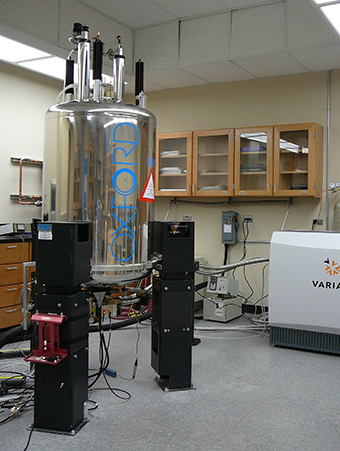Mission : Capabilities : Importance : Function : Services : Sample : Cost
Laboratory Description : NMR Spectrometer, Varian 500 MHz Unity Plus
Mission
The mission of Biomolecular NMR facility is to assist K-State life science researchers interested in (1) characterizing protein domain constructs of novel biologically-important gene products, (2) developing robust and general methods for high-level expression and isotopic (15N, 13C and 2D ) enrichment of these domains for NMR studies, (3) applying multi-dimensional NMR methodology for determining 3D structure of these domains and in studying binding of inhibitor on protein molecules, and (4) identifying the small molecular weight metabolites by means of NMR spectroscopy. The goal of the Functional Genomics Consortium, funded by the K-State Targeted Excellence Program, is to facilitate utilization of functional genomics strategies aimed at both small and large biological problems, and, in particular, to enhance the ability of investigators to analyze gene function at the protein and metabolite levels. To this end, a research associate at the facility will be available to interact extensively with users, providing support and education.

Capabilities
The facility contains more than $1,000,000.00 in research equipment including a ‘state-of-the-art’ 500 MHz Varian NMR Superconducting Spectrometer System equipped with pulsed field gradient accessory, a four channel detection system, two waveform generators, a 5mm latest generation carbon enhanced Cold Probe, a 3 mm [1H/13C/15N/31P] Penta probe, a 5mm [1H/13C/15N] triple resonance and indirect detection probe and a 5 mm [15N-31P] broadband probe with high stability temperature controller for multinuclear/multi-dimensional NMR experiments. Five Linux workstation with XPLOR/CNS modeling programs and processing software are available for off-line NMR data processing and storage, and 3D structure calculations.
Importance
This spectroscopy is still the only method of determining 3-D solution structure of proteins and other macromolecules at the atomic level. An NMR study provides information that is sometimes unique and hard to obtain with other techniques. The dynamic phenomena, responsible for understanding how proteins achieve their unique function; can be studied by NMR spectroscopy.
Function
NMR spectroscopy uses the magnetic property, called spin, of a nucleus in an atom. When a sample is set in a strong magnetic field, it is possible to transfer energy into the spin system in the form of radio frequency pulses and this changes the energy level of the spins. After the pulse the spin system relaxes back to its equilibrium state, sending a weak signal that can be recorded. The 3D structure of molecules can be obtained from these individual signals.
Services
• 3D solution structures and dynamics of proteins, peptides and other biomolecules.
• Protein interactions with other proteins and ligands.
• Identification and characterization of metabolites and intermediates.
• Homology and computer aided molecular modeling.
In summary this facility is capable to solve structural and dynamics problems in molecular pharmacology, rational drug designing, protein folding and solution phase biostructure. Training, education and consultation for users are also provided.
Sample
0.5 – 2.0 mM Solution (0.2 - 0.5 ml)
Cost
~$10.0- $30.0 per hour depending upon services.
Means for users to acquire preliminary data without fees are also provided.
Laboratory Description
Our laboratory uses state-of-the-art multidimensional NMR spectroscopy along with computer aided molecular modeling to solve structural and dynamics problems in molecular pharmacology, rational drug designing, protein folding and solution phase biostructure. We are interested in utilizing structure of peptides, proteins, enzymes, receptors and acceptors as templates in drug designing. We are also interested in developing programs and routines for computer aided structure and conformation elucidation. Once an accurate model is determined, we use it as a template for design of appropriate constrained peptide ligands. In summary, the integration of above mentioned knowledge such as structure-function and molecular recognition may play a key role for the successful design of pharmaceuticals in the future. Furthermore, these studies can guide the design of future experiments, particularly that employing recombinant DNA technology to create new protein structures useful in developing resistance to insects and diseases in plants and animals.
NMR Spectrometer, Varian System 500 MHz with Cold Probe
The Varian System 500 MHz nuclear magnetic resonance (NMR) spectrometer with Cold Probe is located in the NMR Facility (Chalmers Hall). The console is equipped with four radio frequency channels and a Z-axis gradient amplifier and is controlled by a Linux computer connected to the network. Researchers use this system to perform solution-state NMR experiments and metabolomic studies.
-
Contact Information:
Mary L. Vanier NMR Laboratory
Department of Biochemistry
037 Chalmers Hall
Kansas State University
Manhattan, KS 66506 USA
Phone: (785)532-3108
Fax: (785)532-7278
Email: omp@ksu.edu
aiahz@ksu.edu